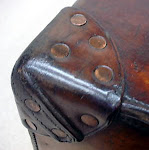Hand stitching:
Almost all British leathergoods (including many handstitched items sold by saddlers and harness makers around the country) were made in factories in the West Midlands. It is well worth a trip to the Leather Museum in Walsall to find out more. Many items were machine stitched which can pose problems for a restorer.
It is very difficult to replicate a machine stitch by hand, but with care a respectable job can be done. First clean out all the old thread from the area that needs to be repaired. Use your brush and a pair of tweezers to ensure the job is properly clean before you start. A scalpel is useful to cut away loose threads.
It is possible to find linen threads in various colours and sizes similar to those used by the original machinists but it is essential to make as good a match as possible if the repair is to look respectable.
Having cleaned out the stitch holes, and using two blunt harness makers needles - threaded one on each end of a length of beeswaxed linen thread - carefully start to restitch the damaged area. Do not use sharp embroidery needles as these can damage the leather fibres and are harder to work with.
First pass the thread through the stitch holes until you have an even amount each side. Then take one needle and pass it halfway back through the work and take the other needle and do the same.
Grasping both needles, one in each hand, pull them through the work and tighten the thread to make a stitch. Be careful not to pull the thread too hard as the leather will tear through very easily. Continue until you have made the repair. To finish the job, simply back stitch two or three holes and cut the loose ends off close to the work.
Thursday, 11 December 2008
Subscribe to:
Post Comments (Atom)






No comments:
Post a Comment